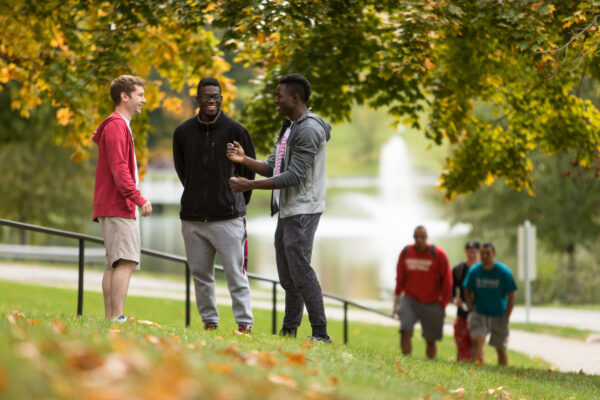By Warrenetta Crawford Mann, Aesha L. Uqdah, and Barry A. Schreier
As campus climates continue to be impacted by COVID-19 and racial unrest and violence, a critical flashpoint is occurring in higher education. Within these dual crises, colleges and universities are specifically being pressed to address ongoing discrimination, microaggressions, and other forms of racialized violence and systemic inequities on campuses. Race and racism are complex issues, and campus leaders must not allow that complexity to impede progress toward healing.
Many campuses have well-developed campus services that allow them to respond to traumatized community members. These community members then often require opportunities to heal, in part, to continue to be active, healthy, and productive. Tools used in trauma response are typically available through trained campus staff in counseling centers or offices that focus on Title IX, health and well-being, victim advocacy, and others. You may have heard about the value of operating with a trauma-informed lens—this post shares more on how such a lens can operate outside the counseling centers and how you can incorporate it in different campus practices to address race-based incidents on campus.
Operating with a trauma-informed lens involves shifting from asking victims of trauma “What is wrong with you?” to “What happened to you?” A trauma-informed campus takes into account that students’ life experiences are key to supporting their engagement on campus and their educational outcomes, instead of an institution assuming a one-size-fits-all approach.
College and university leaders play a critical role in mapping the path forward in addressing the many issues raised by discrimination, microaggressions, racialized violence, and systemic inequities. Working with a trauma-informed lens can help campus leaders build restorative practices that are systematically woven into the way an institution supports students, such as flexible academic policies for those who have experienced traumatic incidents, or incorporating open dialogue into campus activities. Where administrators in the past may have offered predetermined paths forward, they can shift to allow those who feel harmed to name and define what will help them heal.
The following are broad lessons for how this process can work:
Listen
Trauma-informed campuses create forums for impacted students to have their voices heard, provide advocates who assist students in sharing their voices, and provide processes for support rather than asking the student to prove themselves and to prove that harm occurred. Bias reporting systems must provide safe, non-judgmental spaces for minoritized students and their allies to share what happens on campuses related to race, which can include microaggressions and hate crimes. Campus responses should not recapitulate narratives of victim blaming, invalidation, or shaming when students decide to come forward to share the truth of their experiences.
Validate
Trauma-informed campuses validate students who experience hate crimes and microaggressions. There are several reasons why people who experience trauma do not report the incidents to authorities. One common reason is fear that they will not be believed. Black and brown students, staff, and faculty have been reporting experiences of inequitable policing, hiring practices, and the differential impact of academic freedom and campus climate long before videos and social media began to document them.
Campus leaders should be intentional about validation as a key part of a trauma-informed response. Simple and timely acknowledgement of an incident, as a starting point, should not be underestimated in its validating impact. When students’ voices about their lived experiences on campus go unaddressed or are questioned as to their veracity, those voices eventually become silenced.
Support
Trauma-informed campuses create sustainable and systemic support for students whose experiences with racism impact their well-being and their ability to persist in pursuing their education. Campus approaches to diversity, equity, and inclusion can begin as a response to a specific critical event or with a proactive assessment of campus climate, but they cannot stop there. For example, institutions can create solutions such as bias reporting structures that include a clear process and tangible outcomes, or a set of institutional diversity and equity goals that adhere to specified timelines. When institutions fail to provide sustained and structurally supported initiatives, systems, and opportunities for every student to thrive on campus, they fall well short of satisfying the role that higher education is intended to play.
Accommodate
Trauma-informed campuses assess the needs of those who are targeted or impacted by microaggressions and hate crimes and then provide appropriate accommodations for those students. To that end, individuals and the campus community must recognize that these traumatic experiences likely involve people, places, and services that are integral to their education, e.g., a classroom or their on-campus job.
Can a class meeting location be changed? Should staff or faculty involved undergo additional training? Campus leaders should meet with student representatives to plan for reasonable and impactful changes. Campuses can also evaluate those accommodations necessary for an equitable campus by critically examining their community’s rituals and traditions. Just because an event or ritual has “always been” a certain way does not preclude such rituals from evolving with what are changing and increasingly diverse campus communities overall.
Advocate
Trauma-informed campuses advocate for marginalized students. In many communities, colleges and universities are the largest and most powerful employers, so it is vitally important for the well-being of that community that institutions advocate for their most vulnerable students. More and more institutions of higher education are undertaking the advocacy work required to understand how they have been built and sustained on the backs of Black and brown people, from slavery to the present.
However, it is not enough to just look back. Two ways colleges and universities can lead real cultural change are 1) providing living wages for employees and 2) creating research collaborations with community organizations that benefit the local marginalized communities in which the college or university is situated, while providing services and experiential learning for students.
Join
Trauma-informed campuses join with students who have minoritized identities and who use their voices to speak up, act, and seek change. Campus leaders with power, centralized identities, privilege, and access to resources must be willing to act not only in words but also in deeds, especially when they do not share identities with those who are experiencing trauma. Without people who have power and privilege joining in, showing up, and lending their voices, the campus community is at risk for continually marginalizing their Black and brown students. Social justice is a public health matter and is essential for student and campus well-being.
As campuses deal with the impact of COVID-19 and systemic racism, campus leaders have an opportunity to make sustainable, structurally supported change that provides foundations for reparation, reconciliation, and healing for campus communities. The trauma-informed lens readily lends itself to understanding the impact of racialized trauma as well as what all members of campuses can do to take a trauma-informed approach. In doing so, campus leaders create better chances that all students have equitable opportunities to join campus communities, using their natural talents to matriculate, and accessing what campuses have to offer to help them become fully contributing members of society.
If you have any questions or comments about this blog post, please contact us.


